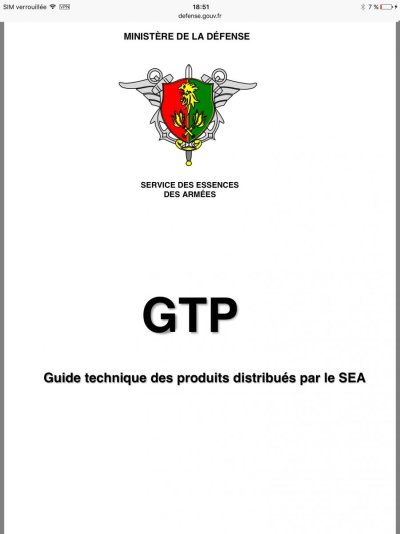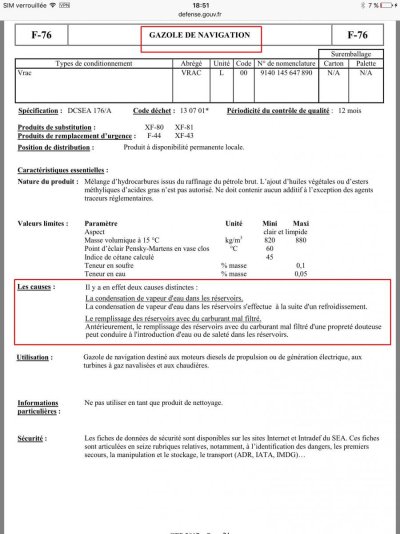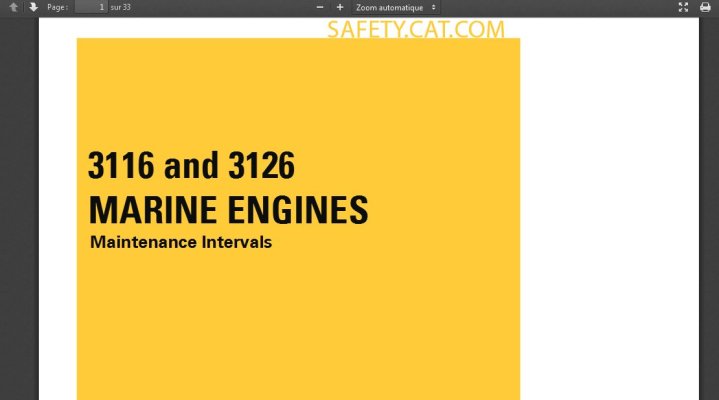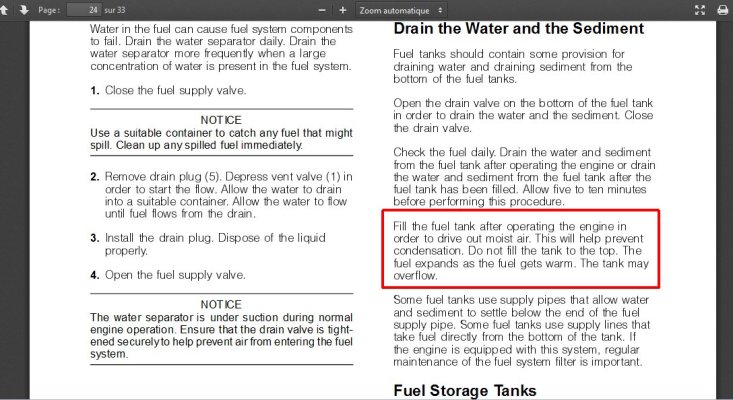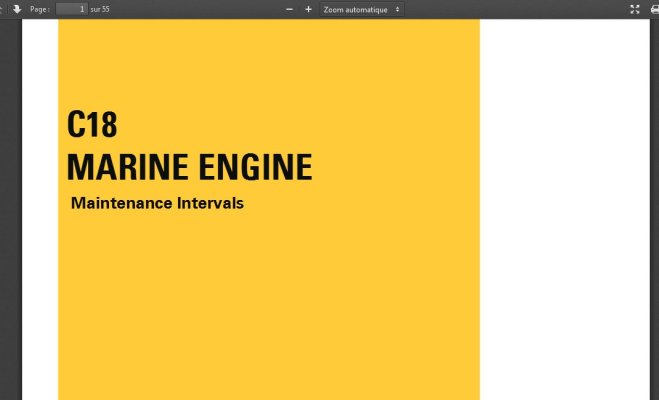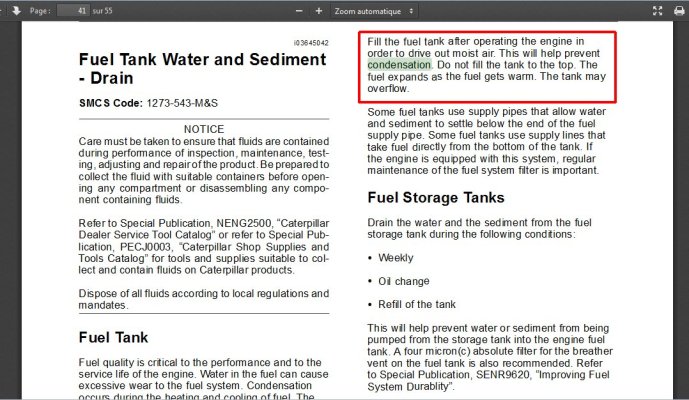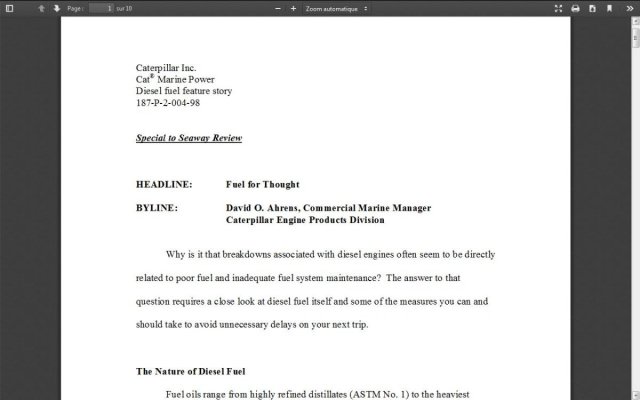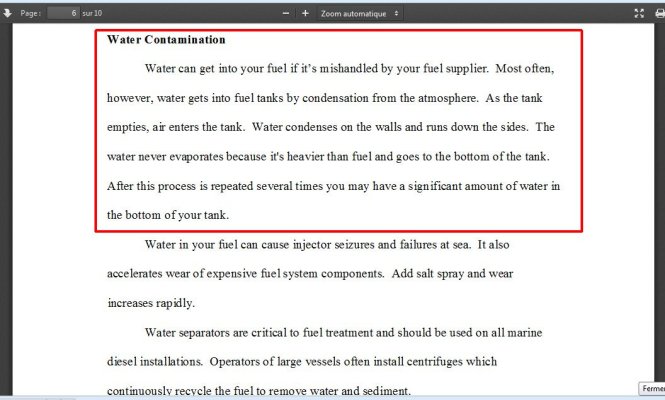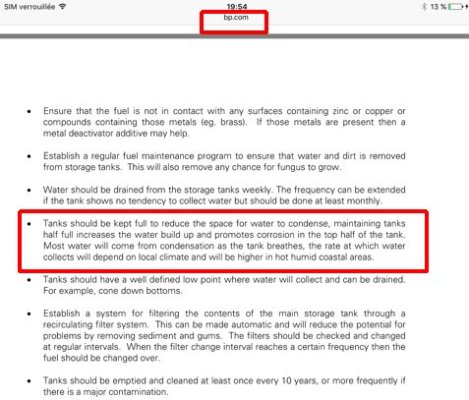That is what we all have heard and many of us have repeated. Can you provide any actual evidence to support it however?
Yes Your Honor, I have some, even if I have no illusions to be heard.
- Photos 1 & 2 : The recommendations from the French Ministry of Defense to the French Navy for motor fuel safety standards which an official copy is attached below :
Gazole de Navigation - Eau.
Il y a en effet deux causes distinctes. La condensation de vapeur d'eau dans les réservoirs s'effectue à l'occasion d'un refroidissement.
Diesel navigation fuel - Water.
Indeed there are two different causes. Water is condensing in the fuel tanks when temperature is dropping. etc..
- Pictures 3 & 4 : Caterpillar 3116 (my engines) / 3126 Marine engines maintenance Manual :
Fill the fuel tank after operating the engine inorder to drive out moist air. This will help prevent condensation. Do not fill the tank to the top. The fuel expands as the fuel gets warm. The tank may overflow.
- Pictures 5 & 6 : Caterpillar C18 Marine engine maintenance Manual :
Idem :
Fill the fuel tank after operating the engine inorder to drive out moist air. This will help prevent condensation. Do not fill the tank to the top. The fuel expands as the fuel gets warm. The tank may overflow.
- Pictures 7 & 8 : From Caterpillar Inc: Headline "Fuel For Thought" which stated :
"Water Contamination.
Water can get into your fuel if it’s mishandled by your fuel supplier. Most often, however, water gets into fuel tanks by condensation from the atmosphere. As the tank empties, air enters the tank. Water condenses on the walls and runs down the sides. The water never evaporates because it's heavier than fuel and goes to the bottom of the tank. After this process is repeated several times you may have a significant amount of water in the bottom of your tank."
- Picture 9 :
Recommendations from BP (formerly British Petroleum) / BP.com.
Tanks should be kept full to reduce the space for water to condense, maintaining tanks half full increases the water build up and promotes corrosion in the top half of the tank. Most water will come from condensation as the tank breathes, the rate at which water collects will depend on local climate and will be higher in hot humid coastal areas.
Even if I am not a specialist in "condensation in hundreds of boat and empty fuel tanks" let me state my own opinion about this. A part of the water found in fuel tank comes from condensation which precipitate on the inside walls of the tanks when temperature is dropping. It is not difficult to understand that all this water will run down less or more slowly. Therefore the walls will dry until the next time this process (condensation from the atmosphere) will happen again, and so forth.
When opening the tanks for a control, it is not surprising to me that the walls could be dry, for the reason there is a chance that the precipitated water would be already down at the bottom of the tank which does not require much time.
Anyway condensation is far more insidious, it varies from weather conditions, from a place to another, from region to region. Thus, not many conclusions can be drawn from that but one : the principle of precaution, which would require that the tanks would be filled up (or to empty the thanks) to allow risks of water from condensation. Since still I am not a specialist in "empty fuel tanks", it seems to me, however, that the tanks of our boats are a lot easier to fill up than to empty... Therefore I keep mine full.
Let us be clear on that : Of course I am very well aware that "free water entry from fuel fills, vents, marina tanks " is a huge issue, Psneel did not re-invent the wheel about that (common & old fashioned French expression to qualify an already very well know idea). I never believed to be right, I was just drawing attention on the logic to keep tanks filled up because the issue of water from condensation is not to be taken lightly. I don't care to be right or wrong, I was here to learn lot of things I don't know and to share my little experience. I just thought that everyone should feel free to participate according to his ideas, without fear of derision or sarcasm which are not very conclusive arguments. Now, I give up with the thread.





